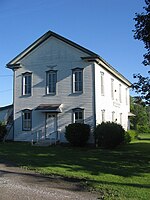Allegheny Airlines Flight 371

Allegheny Airlines Flight 371 was a scheduled passenger flight on December 1, 1959, between Philadelphia, Pennsylvania and Cleveland, Ohio with stops in Pennsylvania at Harrisburg, Williamsport, Bradford, and Erie. The Martin 2-0-2 operating the flight departed Harrisburg with 26 passengers and crew on board and crashed while maneuvering to land at Williamsport Regional Airport in poor weather. A passenger was the sole survivor. Of the 26 passengers and crew many came from Pennsylvania or other Mid-Atlantic states, however there were two foreign nationals on board: one from France and the other from Lithuania. The crash was the first fatal accident in the history of Allegheny Airlines and was the deadliest until the 1969 crash of Allegheny Airlines Flight 853. Also the crash was the largest aviation incident in county history, and was the only deadly incident involving Williamsport Regional Airport until the Merion air disaster in 1991.
Excerpt from the Wikipedia article Allegheny Airlines Flight 371 (License: CC BY-SA 3.0, Authors, Images).Allegheny Airlines Flight 371
Armstrong Township
Geographical coordinates (GPS) Address Nearby Places Show on map
Geographical coordinates (GPS)
| Latitude | Longitude |
|---|---|
| N 41.225580555556 ° | E -76.910680555556 ° |
Address
Armstrong Township
17702 Armstrong Township
Pennsylvania, United States
Open on Google Maps






